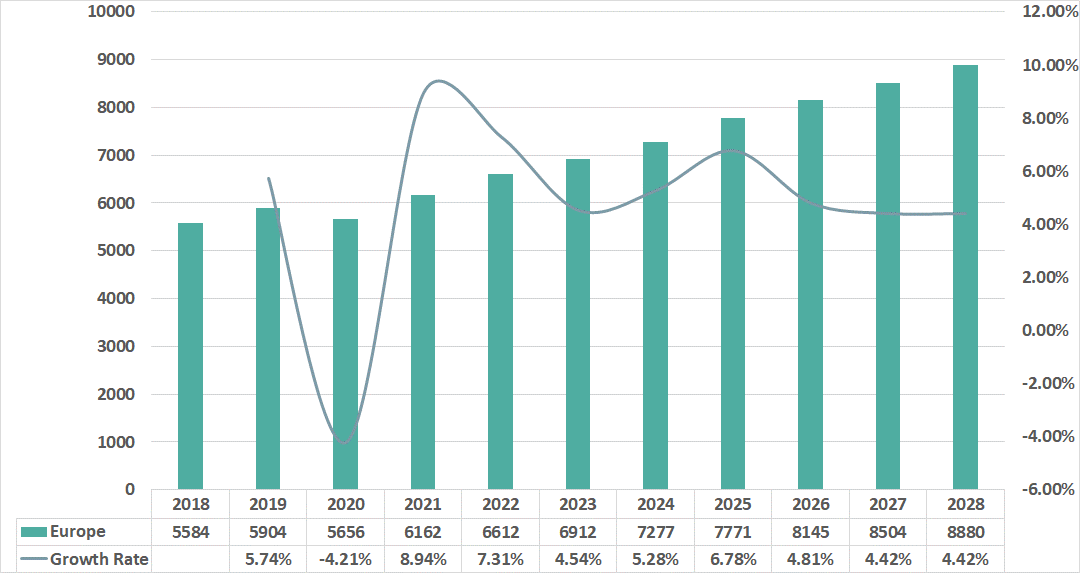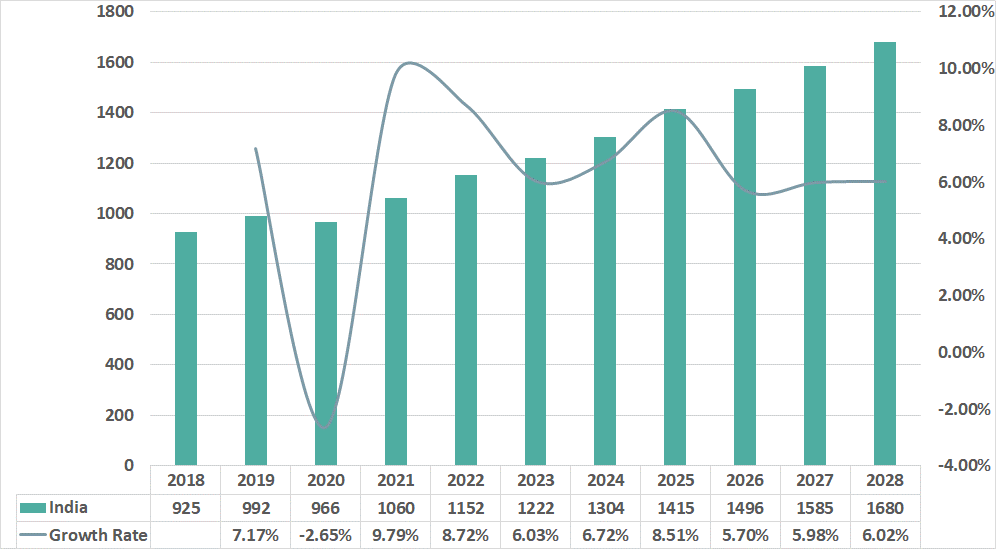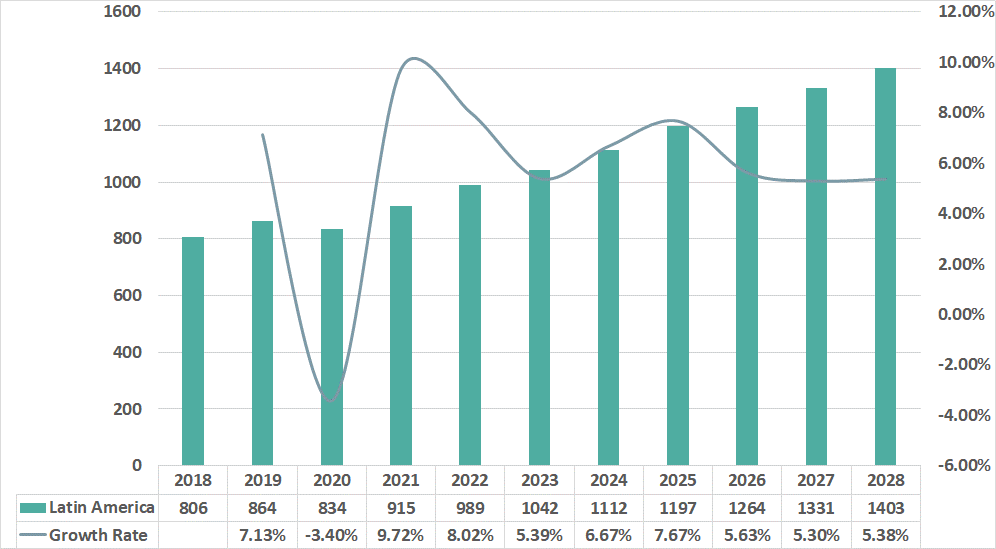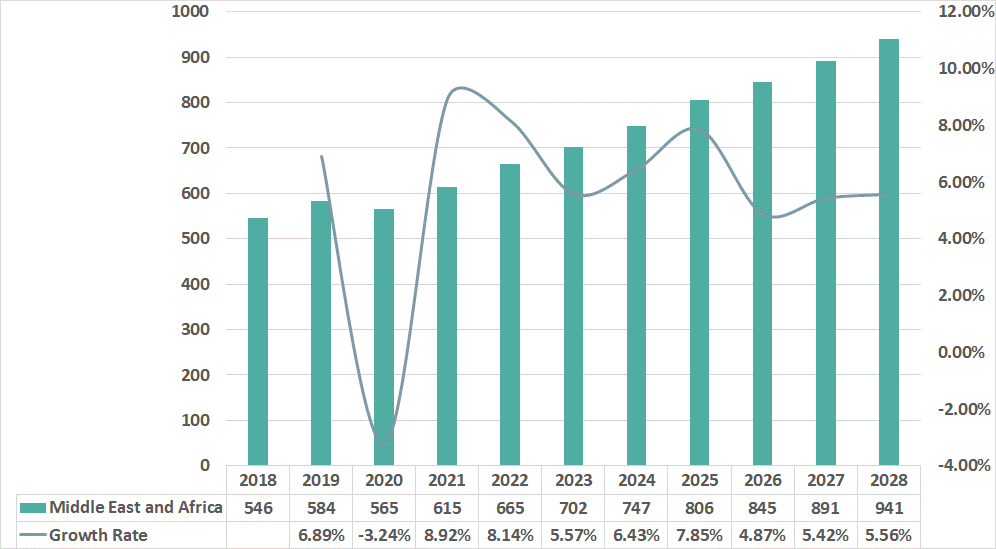Major Regions and Countries on Hair Accessories Market include United States, Europe, China, Japan, India, Southeast Asia, Latin America, and Middle East and Africa.
1 United States Hair Accessories Market
The market size increased from $4,790 million in 2018 to $6,018 million in 2023, and is projected to reach $7,903 million by 2028. The CAGR for the period 2023-2028 is 5.60%.
Figure United States Hair Accessories Market Revenue (M USD) and Growth Rate (2018-2028)

1.1 United States Hair Accessories Market Under COVID-19
The COVID-19 pandemic has created a serious public health and economic crisis in the United States. Consumer services have been hit by the pandemic, job losses, and business closures. Lockdowns and social distancing restrictions have reduced the ability of businesses to produce goods and provide services.
In addition to consumer spending, the COVID-19 crisis has hurt U.S. industrial production. In manufacturing, workers were unable to work remotely and output plummeted. COVID-19 concerns have had a huge impact on the U.S. labor market. Data from November 2021 shows that in the past 7 days, 20 million households did not have enough to eat, and 10 million households defaulted on rent. The number of long-term unemployed who have been unemployed for more than 27 weeks is 2.3 million, an increase of 1.2 million from before the epidemic.
By early 2022, there were about 3 million fewer jobs than before the pandemic. Overall, sales, construction, real estate, and leasing services posted the largest declines, while finance, insurance, and wholesale posted gains.
2 Europe Hair Accessories Market
Europe Sales grew from $5,584 million in 2018 to $6,912 million in 2023, with an expected market size of $8,880 million in 2028. The CAGR is 5.14%.
Figure Europe Hair Accessories Market Revenue (M USD) and Growth Rate (2018-2028)

2.1 Europe Hair Accessories Market Under COVID-19
The coronavirus crisis is challenging the European economy and the livelihoods of its citizens. The economic impact of the coronavirus crisis will vary by industry and company, depending on a variety of factors, including the potential for adaptation to supply chain disruptions and the presence of inventories or reliance on just-in-time production processes. On November 11, 2021, the European Commission published its economic forecast for autumn 2021.
The EU economy is recovering faster than expected from the pandemic recession. The economy resumed in the spring and continued into the summer as vaccination campaigns advanced and restrictions began to lift. The EU economy returned to pre-pandemic output levels in the third quarter of 2021 and shifted from recovery to expansion. The EU economy is expected to continue expanding within the forecast range, with growth rates of 2.5% in 2023. That outlook depends on the evolution of the pandemic and how quickly supply adapts to rapidly changing demand as the economy reopens.
3 China Hair Accessories Market
The China market expanded from $4,785 million in 2018 to $6,140 million in 2023, and is forecasted to be $8,207 million in 2028. The CAGR is 5.97%.
Figure China Hair Accessories Market Revenue (M USD) and Growth Rate (2018-2028)

3.1 China Hair Accessories Market Under COVID-19
China is one of the few Asian economies to grow in 2020, at 2.2% in 2020. China’s growth was driven by a surge in infrastructure and real estate investment and exports, mainly medical and protective equipment, and electronics related to working from home. In 2021, the economy grew by 8.1% as demand for Chinese goods fueled a surge in exports as the rest of the world began to ease COVID restrictions and restart their economies.
However, the normalization of economic growth in China has been disrupted by multiple outbreaks of COVID-19 virus variants and resulting movement restrictions. The zero-COVID policy that helps slow the spread of the virus has also led to increased restrictions on business activities, real estate developers will face long-term financial pressure, and weak production in China affects the global economic recovery supply chain.
In December 2022, the Chinese government began to implement a liberalization policy. With a large population base and well-established manufacturing facilities, China’s economy is expected to recover in the short term. The Chinese economy is expected to rebound to 5.2% in 2023.
4 Japan Hair Accessories Market
The Japan market size rose from $1,299 million in 2018 to $1,552 million in 2023, with a projection of $1,932 million in 2028. The CAGR is 4.48%.
Figure Japan Hair Accessories Market Revenue (M USD) and Growth Rate (2018-2028)

4.1 Japan Hair Accessories Market Under COVID-19
Japan’s economy contracted by 4.6% in 2020 and expand moderately by 1.8% in 2021. Japan’s economy grew 1.1% in real terms in 2022 and is expected to grow 1.8% in 2023 as the country struggles to contain a new virus outbreak.
The COVID-19 pandemic has hit the economy hard, triggering a marked recession. Economic activity has slumped as health restrictions curb consumption and investment. Strong government support and the reopening of the economy have led to some of the rebound. While strong export markets, particularly in East Asia and the United States, are supporting the recovery, slow wage growth is likely to dampen consumption for some time.
New variants of the virus could spark new emergencies and slow the transition from school to work. Growth prospects in Japan are again expected to be hampered by a weaker yen and higher import costs, as higher oil prices and general difficulties in supply chains dent household consumption and businesses. The pandemic has exposed the need to scale up Japan’s digital transformation, where its reliance on physical paperwork has created challenges for businesses, households, and government agencies to shift to remote work.
Japan has a well-developed digital infrastructure and a highly skilled workforce and is at the forefront of technologies such as robotics, but many small companies are lagging in adopting digital tools. Japan needs to increase investment in hardware and research in the technology industry, increase the dissemination of new technologies by enterprises and the government, and carry out more digital skills training in enterprises.
5 India Hair Accessories Market
India Sales increased from $925 million in 2018 to $1,222 million in 2023, and are expected to reach $1,680 million in 2028. The CAGR is 6.58%.
Figure India Hair Accessories Market Revenue (M USD) and Growth Rate (2018-2028)

5.1 India Hair Accessories Market Under COVID-19
India’s economy shrank by 6.6% in 2020. The lockdown had a devastating effect on the slowing economy, with shops, restaurants, factories, transport services, and commercial establishments closed. COVID-19 has hit the informal economy hardest. Private consumption and investment are the two engines of India’s economic growth.
All major economic sectors have been hit hard except agriculture. Nearly half of India’s electronics imports come from China. In light of the coronavirus outbreak and subsequent lockdown, India is considering boosting local production to reduce dependence on the single market. The Indian pharmaceutical industry imports 70% of its active pharmaceutical ingredients (APIs) from China, and as there is hardly enough API to make drugs, drug market prices have skyrocketed.
Cultural and historical tourism in India attracts a large number of domestic and foreign tourists. The tourism industry has been hit hard as visas are suspended and tourist attractions closed indefinitely.
The Indian government’s broad-based fiscal, monetary, and health response to the crisis supported economic recovery and, along with economic reforms, helped mitigate the long-term adverse effects of the crisis. The Indian economy was grown by 8.68% in 2021 and 6.5% in 2022. Unemployment in India remains high amid the mechanization of a large number of processes, rapid population growth, and slowing growth in exports and domestic demand.
6 Southeast Asia Hair Accessories Market
The Southeast Asia market grew from $702 million in 2018 to $937 million in 2023, with a forecast of $1,304 million in 2028. The CAGR is 6.82%.
Figure Southeast Asia Hair Accessories Market Revenue (M USD) and Growth Rate (2018-2028)

6.1 Southeast Asia Hair Accessories Market Under COVID-19
The pandemic has caused significant damage to Southeast Asian economies. The lockdown in China has restricted the movement of vital manufacturing chains, with factories running at reduced capacity. The epidemic has led to a reduction in residents’ disposable income and domestic demand. The closure of international borders and domestic lockdowns have dampened tourism, an important economic pillar in Southeast Asia.
Due to COVID-19, 9.3 million people were unemployed in 2021 and 4.7 million Southeast Asians lived in extreme poverty. COVID-19 reduced the region’s GDP by 0.8% in 2022, reducing output by more than 10% compared to 2020.
7 Latin America Hair Accessories Market
Latin America Sales increased from $806 million in 2018 to $1,042 million in 2023, and are projected to reach $1,403 million in 2028. The CAGR is 6.13%.
Figure Latin America Hair Accessories Market Revenue (M USD) and Growth Rate (2018-2028)

7.1 Latin America Hair Accessories Market Under COVID-19
COVID-19 has had widespread economic, social, and political impacts in Latin America. Brazil, Argentina, Colombia, and Peru are the countries with the highest death toll in the region, with Brazil leading the global death toll behind the United States. Government control will be key to the subsequent development of COVID-19 pneumonia.
However, due to the global COVID-19 pneumonia epidemic, the local manufacturing industry in Latin America has been affected, especially the increase in the number of infections in Brazil, and the decline in trade will be more pronounced. In addition, countries with weak public health infrastructure and limited fiscal space will face intense pressure to increase public health services and support affected sectors and households.
8 Middle East and Africa Hair Accessories Market
The Middle East & Africa market size rose from $546 million in 2018 to $702 million in 2023, with an expected market size of $941 million in 2028. The CAGR is 6.02%.
Figure Middle East and Africa Hair Accessories Market Revenue (M USD) and Growth Rate (2018-2028)

8.1 Middle East and Africa Hair Accessories Market Under COVID-19
The economy, politics, and society of Middle Eastern countries have been severely affected by the epidemic. Judging from the experience of the Middle East and African countries in responding to the epidemic in recent years and the current situation of epidemic prevention and control in various countries, the ability of the Middle East and African countries to respond to public health incidents is relatively low, and the prospects are not optimistic.
The COVID-19 pandemic could further burden public services, render neglected public health infrastructure dilapidated, and revive geopolitical competition in the Middle East and Africa. The pandemic is likely to affect the Egyptian economy, mainly due to reduced travel and tourism activity, lower remittances from workers, capital outflows, and a slowdown in domestic activity.
Weak demand in global markets will also reduce Egypt’s exports and Suez Canal revenues. With the spread of the epidemic around the world, the manufacturing industry in the Middle East and Africa has been significantly affected, and the growth rate has slowed down significantly. In oil-exporting countries, the plunge in oil prices has exacerbated challenges related to COVID-19.





